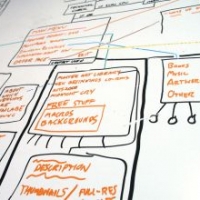How Visual Thinking Can Solve Project Management Problems

After launching a project, have you ever found yourself without a clear vision of the next steps? That stomach-churning feeling of wrapping your mind around a new project's immensity can be justified—companies spend crazy budgets looking for solutions they need, but oftentimes, the result tends to resemble a vague return of their initial plan. In the worst-case scenario, the end product fails to meet end-users' expectations, which leads to substantial losses.
The solution is to adopt visual thinking—with a strong emphasis on design thinking—from the very beginning. Imagine your finished concept and work toward it. Project teams often immerse themselves too deep in details, carrying out research that doesn't bring the wanted results and then documenting it in piles of paper that nobody else reads.
Here is how to solve your business problems applying visual thinking to the flow of product development.
Understand What Is Needed
Make sure your team clearly understands a project's end objectives. Regardless of the stage of the software development lifecycle or how easy or complex a task seems, remind the team to stay focused on what you are ultimately trying to achieve.
Predict Your Problems
Try to solve your future problems at the first meeting. The more potential solutions you come up with, the broader your end result possibilities will be. Create a culture of “no wrong questions” where everyone can offer input from the get-go. As a manager, don’t fall in love with your earliest idea—be flexible so that real problems can effectively be solved as they become apparent.
Structure the Process
Build an infrastructure to solve problems. A good practice for structuring a problem that arises is a tree of questions—every question arising from a current hypothesis may branch out into more detailed questions, and so on:
- Should it be developed as a new product?
- Should it be developed as an add-on?
- Are we capable of introducing these changes?
- Do we need special skills?
- Is our budget enough for project implementation?
- Can we deliver high quality within our current restraints?
A set of questions leads to a clearly formulated, detailed hypothesis and lays the foundations for further road-mapping the workflow. The tree of questions is also helpful in identifying "fruitless branches" in the course of analysis.
Embrace a Complex Vision
Sometimes the coexistence of dozens of tasks appears to be a distraction, but the key is to make sure this proliferation doesn't have a detrimental effect. When you feel like you are being eaten alive by external and internal side-tracking details, take a step back and look at your project as a general picture, not a partitioned set of tasks.
Ask yourself, "What is the place of every task I am tackling in this puzzle?" Does it really fit this canvas? If not, then don't bother wasting your time on it.
Conclusion
You can't accomplish a project without envisioning its outcome. Graphically visualize the result of your projects so you stay focused. Come up with a clear idea of what you need to achieve, then plan your progress toward the main objective.

